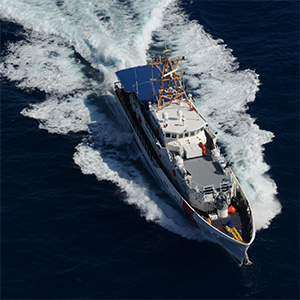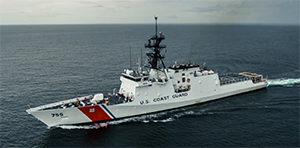The changing of presidential administrations has brought a lot of uncertainty to the federal budget process, with President Trump’s public support of programs often tempered by contradictory realities when the rubber hits the road. But one proposal championed by the president and the U.S. shipbuilding industry — expanding the Navy to 355 ships — appears to be gaining traction in the White House and Congress.
The support complements the Navy’s 2016 Force Structure Assessment, which recommends putting American shipbuilding “on an upward glide path” to more newbuilds. In mid-September, the U.S. Senate raised the ante by passing the Securing the Homeland by Increasing our Power on the Seas (SHIPS) Act. The bill would make it U.S. policy to boost the strength of the fleet from the current total of 276 ships.
The plan faces two longstanding challenges for the Navy and American shipbuilders: budget constraints imposed by sequestration, and Congress’ penchant for funding government programs by continuing resolution.
“If we’re going to be honest about a 355-ship Navy, sequestration has to go away,” Matthew Paxton, president of the Shipbuilders Council of America, told American Ship Review. “It has implications that are quite severe.”
Paxton said continuing resolutions are just as harmful to the industry because they don’t allow for strategic planning and effective management when it comes to procurement and scheduling. “CRs” are particularly damaging to shipyards that are heavily focused on Navy vessel repair, he said.
Coast Guard flip-flop
While President Trump has publicly campaigned for more defense spending and a larger Navy fleet, he sent a different message in February when he called for a $1.3 billion cut in the Coast Guard’s budget for 2018. Nearly half of the reduction would have come from canceling production of a ninth national security cutter (NSC) by Ingalls Shipbuilding.
The proposal generated swift opposition from dozens in Congress who said it ran contrary to the president’s stated goal of protecting the U.S. mainland from attacks. Many also cited Russia’s military buildup in the Arctic and the “icebreaker gap” between the two countries.
 |
|
USNS Yuma is the eighth expeditionary fast transport (EPF) built by Austal USA. The 338-foot Spearhead-class catamaran is capable of transporting 600 tons of cargo 1,200 nautical miles at an average speed of 35 knots. |
|
Courtesy Austal USA |
In an address to the National Press Club in March, Coast Guard Commandant Adm. Paul Zukunft defended the service’s record and called for an increase in funding.
“We have always prided ourselves as a service that punches above our weight class,” he said. “Yet, as our nation’s fifth armed service, somehow we find ourselves budgeted at the bottom. Using a boxing metaphor, we are funded in a flyweight class. After 226 years of service, the time is long overdue to up our weight class to at least the middleweight division.”
The backlash may have had an impact. The final Coast Guard budget proposed for 2018 was $9.1 billion, an amount that stayed flat even as the Pentagon’s budget grew by $54 billion. Jurisdiction of the Coast Guard falls under the Department of Homeland Security.
Headway for icebreakers
Progress toward building two new heavy polar icebreakers for the Coast Guard fleet continued in February when the service awarded contracts to five shipyards — Bollinger, Fincantieri, General Dynamics NASSCO, Huntington Ingalls and VT Halter Marine — for design studies and analysis.
The contracts, which total about $20 million, call for the builders to examine major design cost drivers; approaches to address potential acquisition, technology and production risks; and benefits associated with different types of production contracts. The studies are expected to take 12 months to complete, with the Coast Guard awarding a single contract for the design and construction of a lead heavy icebreaker in fiscal 2019.
The new ship cannot arrive soon enough. The U.S. currently has just one active heavy icebreaker, Polar Star, and a medium icebreaker, Healy, which is deployed primarily for scientific research.
Frigate program on hold
Following a critical report from the Government Accountability Office (GAO), the Navy announced in May that it was delaying its $9 billion program to build frigates meant to succeed the littoral combat ship. Lockheed Martin (Marinette Marine) and Austal, builders of the Freedom and Independence variants of the LCS, respectively, are offering competing proposals based on their LCS designs for the new ships.
 |
|
The fast response cutter John McCormick heads for its home port of Ketchikan, Alaska, in April after being delivered by Bollinger Shipyards. A pair of 20-cylinder turbocharged main engines deliver sustained flank speeds of more than 28 knots, according to the Coast Guard. |
|
Courtesy U.S. Coast Guard |
The Navy said it was postponing the contract until fiscal 2020 and did not clarify whether it was delaying its choice of shipbuilder as well. The GAO criticized both LCS variants for cost overruns, production delays and the potential vulnerability in combat.
“The Navy envisioned a revolutionary approach for the LCS program: dual ship designs with interchangeable mission packages intended to provide mission flexibility. This approach has fallen short,” the GAO said.
Here are other highlights of defense-related activity at U.S. shipyards during the past year:
• General Dynamics NASSCO of San Diego began construction of a fifth ship for the Navy’s expeditionary transfer dock (ESD)/expeditionary sea base (ESB) program. The 784-foot ESB 5 will feature a 52,000-square-foot flight deck to support helicopters and MV-22 tilt rotor aircraft.
• Ingalls Shipbuilding delivered its sixth national security cutter, Munro, to the Coast Guard in December 2016, and the amphibious transport dock Portland (LPD 27) to the Navy in September. The Pascagoula, Miss., shipyard also received a $3 billion contract for the production of the amphibious assault ship USS Bougainville (LHA 8) and a $1.4 billion contract for Fort Lauderdale (LPD 28).
• From late October to late June, Bollinger Shipyards of Lockport, La., delivered five fast response cutters to the Coast Guard: Lawrence Lawson, John McCormick, Bailey Barco, Benjamin Dailey and Oliver Berry. The 154-foot Sentinel-class FRCs are replacing the Coast Guard’s 110-foot Island-class cutters.
• Austal USA delivered two Independence-variant LCS trimarans to the Navy, Gabrielle Giffords (LCS 10) and Omaha (LCS 12), and christened two others, Tulsa (LCS 16) and Charleston (LCS 18). The shipyard in Mobile, Ala., also delivered the expeditionary fast transport Yuma (EPF 8).

